Table of Contents
African Sideneck Turtle: A Brief Introduction
African sideneck turtles are freshwater turtles native to Africa with a long, retractable neck and high-domed shell. They are popular as pets and require a large enclosure with access to both land and water, and a varied diet.
African Sideneck Turtle Overview
When thinking about a home aquarium, housing a turtle is not everyone’s first choice. Not only are they an entirely new species than fishes, but they also come with their own set of challenges and maintenance.
That isn’t the case with African Sideneck Turtles. These 9-11” long semi-aquatic reptiles are predominantly found in the wild across western and Central Africa. They are found in freshwater bodies, including rivers, ponds, marshes, etc.
This turtle comes from the family of Pelomedusidae. Interestingly, this aquarium’s favorite turtle is often an African helmeted turtle or African mud turtle. The turtle will not completely bury its head in its shell-like some other turtles do. To withdraw when faced with a threat, the turtle is known to fold its head below the upper edge of its shell, especially after its head has been coiled to the side. The African Sideneck Turtle is unique and can make a great addition to your aquarium. They are known to live more than fifty years or even more when in the wild.
The side necks usually have necks that are longer than many other species of turtles. This adaptation is said to give them better survival chances in the wild than other turtles’ species. If the turtle is turned upside down on its shells, it can use its rather long neck to get back on its feet.
| Information Chart | African Sideneck Turtle |
| Scientific name | Pelomedusa subrufa |
| Family | Pelomedusidae |
| Care level | Easy to Intermediate |
| Temperament | Calm |
| Color | Tan, dark brow, grey, black |
| Lifespan | 25-50 years |
| Size | 7-12 inches |
| Diet | Omnivore |
| Minimum tank size | 70-100 gallons |
| Temperature | 70-85 degrees Fahrenheit |
| Water conditions | Freshwater |
| Tank mate compatibility | Prefer being alone |
African Sideneck Turtle Appearance

The African sideneck turtle usually varies from one turtle to another, especially regarding their overall sizes. There are varieties of turtles that will be one foot long in maturity, there are those that will be twenty inches long, but there are those that will be just around six to eight inches long.
The Africa sideneck turtle exhibits two barbells that extend from its lower jaw. The animal uses them as a sensory organ, and people who do not know them may mistake them for beards. The turtle has got feet that are slightly webbed with long sharp claws. The turtle has got large round eyes with a mouth that appears as if it is smiling.
The turtle usually varies from tan, dark brown, grey, to black in terms of the general coloration. Some turtle varieties will exhibit lighter skin tones, but most of them usually show darker skin tones on their underbelly areas. You will also spot a wide yellow-colored area on the body of the turtle.
The turtle’s head appears brown with a black marking, evident on the top part of the head.
Even the entomologists working with these turtles have reported saying that they have a very different structure and appearance than a standard turtle. They lack the ardent reptilian features and have a cute shape and a smile mimicking on the mouth.
As for the availability of subspecies, the sideneck turtle doesn’t have any distinctive ones. However, it is described into three variations:
- Normal form
- Rainforest form
- Savannah form
The rainforest form is when the turtle adapts itself into a very dark brown or black shell on the exterior, while the savannah form mimics ones with a lighter and buttery tanned appearance.
Lifespan of African Sideneck Turtle
The typical lifespan of an African sideneck turtle varies between 25-50 years.
The same is dependent on their living conditions and the kind of environment they are growing in the captivity. In the wild, they generally live for 40-50 years.
African Sideneck Turtle Size
The typical sideneck turtle grows up to 9-11 inches when they attain maturity.
According to studies, the female sidenecks tend to reach a more extended size than males. The males can grow up to a maximum length of 10 inches, while a female sideneck can grow up to 12 inches.
Natural Habitat and Origin
The turtle is native to the African continent, specifically the East African region in common east African states of Seychelles, Madagascar, and other freshwater regions.
The turtle is usually found naturally inhabiting small ponds, streams with slow-moving water, and even small lakes. It likes to inhabit clean water that is free of impurities, and this, therefore, calls on you to provide conditions that are almost similar to its habitat in captivity.
African Sideneck Turtle Care and Tank Set-up
The African Sideneck Turtle inhabits clean waters and needs to be housed in a spotless tank similar to the environment it is accustomed to in the wild. The basic rule of keeping this turtle in captivity is to have a large tank with the minimum being at least 75 gallons capacity for a single turtle. A larger turtle tank will allow the turtle to have ample space for swimming and also dive.
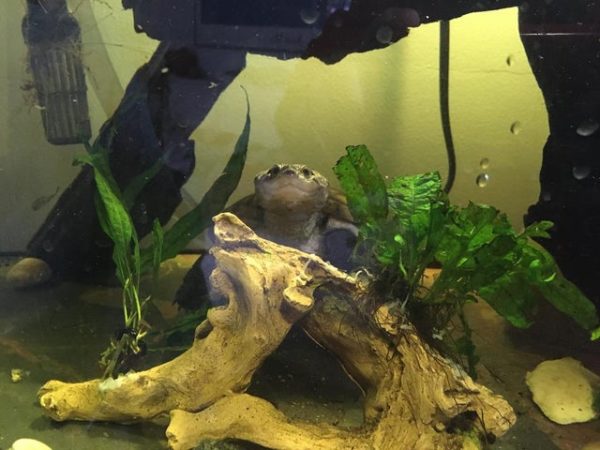
Related Review: Best Turtle Tanks
For more details and tips about tank requirements for the African sideneck turtle read below:
African Sideneck Tank Size and Specifications
Although it is true that the African aquatic sideneck turtles don’t require a lot of maintenance, they do need their space to grow and live a healthy life in captivity.
Optimum Tank Size for African Sideneck Turtle
The minimum tank size for the sideneck turtle is between 90-110 gallons. Also, the length of the aquarium should be 1.5x longer than the actual size of the turtle. However, these are minimum requirements, so if you have access to larger tanks, that is always a welcomed option.
While it isn’t possible for all caregivers, try to keep the turtle for the first year in a pond to help it adapt and acclimatize to the changes before you shift them to your home aquarium. Also, avoid keeping more than one sideneck turtle in the enclosure.
Filter Type
Although it might seem irrelevant, keeping a high-quality filter in the home aquarium is pretty essential. This is primarily because the aquatic sideneck turtles defecate in the aquarium. Without a high-speed filter with proper fans and blades, you will have to change the water every 5 days to a week.
If you had to choose, we’d recommend looking between canister filters or the smaller submersible filters. However, if you house the turtle in a larger tank, the canister filters are a superior option.
Also, chlorinating the water is a necessity. You can always add a dechlorinating solution now and then to keep the water clean and free of disease-spreading germs.
Substrate
Adding high-quality substrate to the bottom of your aquarium is necessary. This mimics the natural environment of the wild, making it easier for the turtle to adjust.
However, what kind of substrate you put into the tank is essential. You don’t want to overdo the substrate, sand, and pebbles. Also, try to avoid putting substrates that could end up becoming a choking hazard for the turtle.
How many African Sideneck turtle should you keep in a tank?
If you house a standard 70-100 gallons aquarium, we’d recommend that you keep only one turtle per tank to reduce the risks of diseases and other stress-inducing factors.
Water Parameters for African Sideneck Turtle
The African sideneck turtles are semi-aquatic creatures, which means that they spend most of their time underwater. So, transforming your home aquarium to match the needs substantially is going to be crucial.
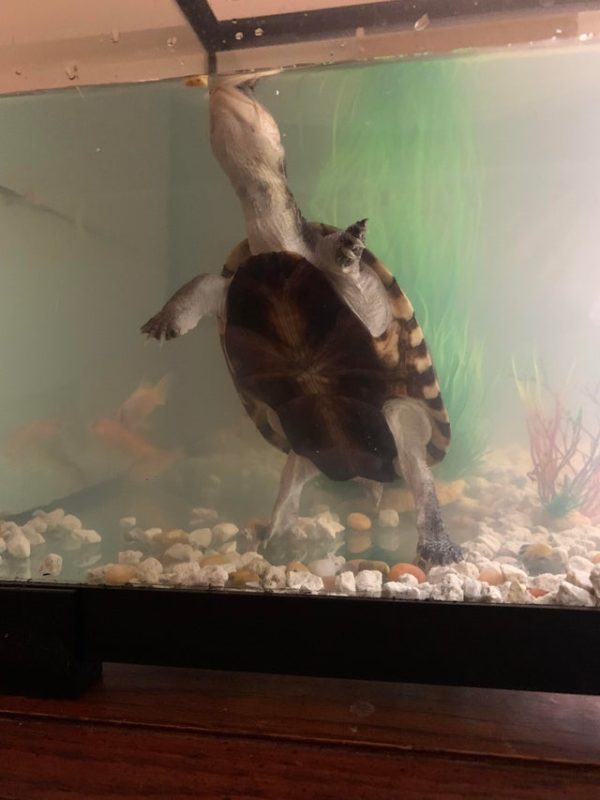
Here are a few water parameters that you need to be mindful of when housing an aquatic sideneck turtle.
Water temperature
The African sideneck turtles, unlike staple mammals, need external sources of heat and cold to regulate their body temperature. Proper temperature of the water is also crucial in maintaining their body’s metabolism as well.
The ideal temperature of the water for an African sideneck turtle should be between 70-85 degrees Fahrenheit. The juveniles require a water temperature between 80-85 degrees Fahrenheit. If you aren’t sure of the temperature, make sure that you have a digital probe thermometer to keep an eye out for.
If the temperature isn’t warm enough, you can place two overhead halogen flood heat lamps on one side of the enclosure. Avoid unnecessarily heated bulbs like ceramic heat emitters, blue bulbs, etc.
pH Level for African Sideneck turtle
The ideal water pH for an African Sideneck turtle is between 6.5 to 7.
African Sideneck Turtle Tank Landscape
When it comes to decorating the landscape of the home aquarium for the sideneck turtle, you need to space everything out. The last thing you want is to end up with a tank that is overfilled, leaving no space for the turtle to grow and freely move around.
The first integral piece of the tank landscape is the base or the land that the turtle will bask on. Since these are semi-aquatic creatures, as much as they prefer being underwater, they need some land to stay on. The land essentially helps the turtle burrow and to rest and walk around a bit.
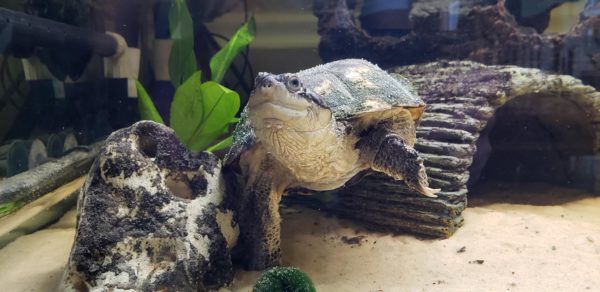
As for the decoration, you can always include items like:
- Live or fake plants
- Driftwood
- Fine particle substrate like sand
- Hollow logs
Despite what you add in the tank, you need to provide the turtle with enough space to move around in the tank and hide out whenever they feel restless or overwhelmed.
Lighting for African Sideneck Turtle
While the plants and decorations aren’t the main focal point, you need to be mindful of the lighting. They are in specific need of UVB lighting to be able to metabolize calcium properly. You don’t have to keep the light switched on for the whole day.
A 12 hours day and night cycle with the UVB lamp is enough to keep your turtle healthy and in its best shape. Also, for the placement, you need to ensure that these lights are placed 12 inches away from the turtle.
These UVB lights don’t come with a prolonged lifespan, and there are chances that you might have to replace them every 6-9 months, depending on the functions. This is one of the necessities for an African sideneck turtle that you can’t miss out on because lack of exposure to UVB lighting can cause metabolic bone diseases in their body.
We think you’ll like: Best Turtle Tanks Filters
Feeding African Sideneck Turtle
Like many other freshwater turtles, the Africa sideneck turtle is omnivorous that feeds on plants and small animals. When you are feeding your aquatic sideneck turtle in captivity, maintaining variety is key.
As for the feeding frequency, you need to feed your sideneck turtle every 2 to 3 days. Also, the diet of the sideneck turtles tends to change depending on their age. The diet of a sideneck turtle below one year is different from one above 1 year of age.
Best Diet for African Sideneck Turtle
Here’s a quick breakdown:
For younger than one year:
- Combination of 50% protein and 50% vegetables
- Feed protein as much as they can in under 5 minutes
- Feed vegetables in the same amount as the shell size of the turtle
- Turtle pellets should be given every other day
For older than one year:
- Combination of 25% protein and 75% vegetables
- Feed protein-rich food once or twice a week as much as they can eat in under 5 minutes
- Feed vegetables every day the same size as the shell of the turtle
- Turtle pellets twice or thrice a week
Best animal-rich foods
Protein sources are derived from animal sources like:
Best vegetable foods
Moving on to the vegetables that are safe for your sideneck turtle, we have:
- Collard greens
- Dandelion
- Green leaf lettuce
- Red leaf lettuce
- Raw grated squash
- Green beans
- Carrots
- Raw grated sweet potato
Make sure when you select the turtle pellet food, you rely on branded and high-quality products that will support the health and well-being of your aquatic African sideneck turtle.
How often should you feed an African Sideneck Turtle?
You should feed your turtle every two days, depending on the food item. Protein-rich sources should be fed twice a week while vegetables can be given every day in small amounts.
Behavior of African Sideneck Turtle
The African Sideneck Turtle is not known to be aggressive but will survive easily in various environments as long as the water is well maintained. They can sometimes get a little aggressive when handled roughly to make them feel threatened.
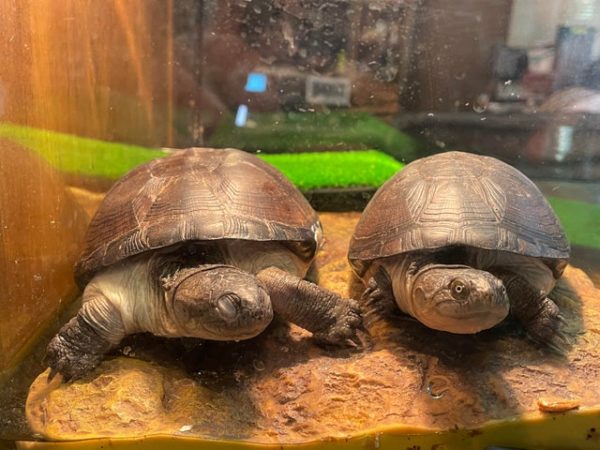
Basically, when the turtle is still new in the aquarium enclosure, it will be somewhat shy but it will get used to the new environment over time. Some owners have reported cases where their pet turtles have become very friendly and outgoing with people within the family they are used to seeing regularly.
Generally, these turtles are shy at first but highly curious. This means that you can effectively watch them move around in the enclosure. They are interactive and will respond well to your voice and gestures once they get used to your presence.
Also, if you are taking them out of the aquarium to hold them in your hand, avoid provoking them. The sideneck turtles can get stressed quickly when they are in new surroundings, so if they seem squirmy and uncomfortable, put them back in the aquarium and avoid touching them.
If you provoke them unnecessarily, there are risks of them biting you, so try to keep the interaction civil and calm. Additionally, the sideneck turtles carry Salmonella bacteria, so rigorously wash your hands after touching them to avoid getting an infection.
One fantastic way to bond with your African sideneck turtle is to tong-feed them every day. It helps build trust, and they don’t see you as an external threat, enjoying your presence.
Are African Sideneck Turtles lone or societal?
These turtles do prefer staying alone and keep to themselves in the tank. So, if you are keeping them in your home aquarium, avoid overcrowding the space with other turtle species or fishes.
Breeding African Sideneck Turtle
The African sideneck turtles lay eggs twice a year, especially during the dry or harmattan season. However, the laid eggs in the dry season hatch during the wet rainy season. In a single cycle, a fertile female sideneck turtle lays 8-16 eggs.
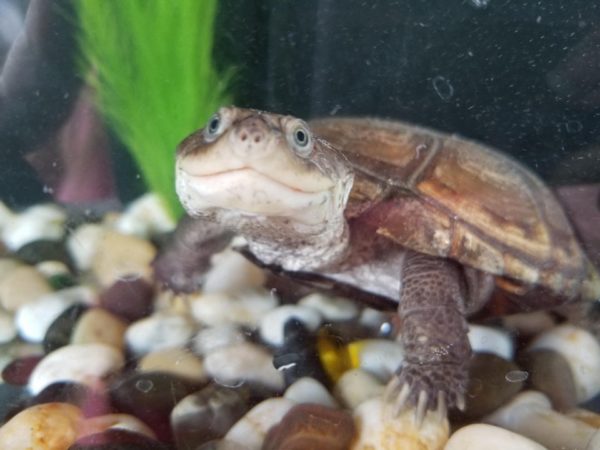
During breeding, the female turtles bury themselves inside the shell to the max. This is done as a defensive mechanism against egg-eating predators. Once the eggs hatch, the juvenile turtles need to be transferred to a clean tank immediately.
They require clean filtered water with optimal UVB light focus on their tank to help their growth and well-being.
African Sideneck Turtle Diseases and their Treatment
Since the sideneck turtles are cold-blooded, they rely on external heat sources like halogen bulbs and UVB lights to keep them warm during their lifetime. Besides the warmth requirement, these turtles are pretty hardy and don’t require a lot of external care.
However, under specific conditions, your African sideneck turtle can suffer from conditions like:
Malnutrition
If you witness the turtle exhibiting signs like swollen eyes or limbs, it signifies Vitamin D3 or calcium deficiency. Open wounds are also a symptom.
Parasitic attack
If there is an internal or external parasitic attack in the water tank, you will witness notable changes in the tank. Not only will the parasites float around in the water, but you will also find your turtle in a lot of distress. Ensure that you consult a vet immediately if that is the case.
Dehydration
Although we wouldn’t recommend touching your turtle often, you need to weigh them twice or thrice every week. Any subsequent drop in their weight is a sign of dehydration or other illness.
Facts about African Sideneck Turtle
If you are into trivia and like to know new facts about reptiles, here are a few about the African Sideneck Turtle:
- The scientific name of the African Sideneck turtle is Pelusios castaneus.
- They are often confused with African helmeted turtles since they have a similar appearance.
- They have a distinctive cute smiling face that distinguishes them from other standard reptiles.
- The carapace of this breed of sideneck turtle has a dark greyish color.
Is African Sideneck Turtle Right for You?
If you aren’t a big fan of reptiles but want to start somewhere and take care of a tiny little guy in your home, the African Sideneck Turtle is a pretty great option. Not only does it look pretty cute, they are hardy creatures too, which means that you wouldn’t have to bend over backward to take care of them.
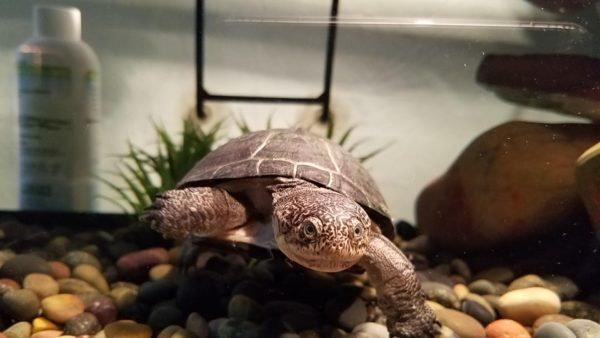
Since they are low-maintenance, they also don’t have a lot of expenses associated with them. Also, when getting an African aquatic sideneck turtle, make sure that you get them from a reputable breeder with ethical practices.
FAQs
Why does my African Sideneck Turtle keep trying to climb out?
It is a bad sign if you find your African sideneck turtle trying to jump out of the tank. The chances are that they are either under stress, not on the proper diet, or have a terrible basking area. If the turtle doesn’t find the surroundings optimal and comforting, they will try to climb out to a safer space.
Why is my African Sideneck Turtle shredding so much?
The primary reason behind a sudden drop in weight is an underlying medical condition. It can be due to dehydration or even malnutrition or parasitic growth in their body. If you notice a drastic change, it is always better to consult a vet to get the cause diagnosed.
How do I know if my turtle is overweight?
The ideal weight of your African sideneck turtle will be deduced by your breeder. If you find sudden puffiness or growth around the hands and legs or the abdominal region, it signifies the turtle gaining weight. Try to consult a vet to get them on the proper diet for a healthy lifestyle.
Why won’t my African Sideneck Turtle eat?
There could be several reasons behind the lack of appetite. Primarily, it is due to a parasitic infection in their body. If they refuse to eat consistently for a few days, get an appointment with the vet or breeder from whom you got your turtle.
Do African Sideneck Turtles eat fruit?
Not predominantly. However, you can feed them small pieces once or twice a week. These turtles primarily rely on vegetables and occasional protein sources more.
How do African Sideneck Turtles sleep?
Most of the sideneck turtles will burrow into the substrate inside the aquarium to sleep or hibernate. However, the mode of oxygen intake varies on the species of turtles we are talking about.
Conclusion
African Sideneck Turtles are not just beautiful to stare at; they are highly interactive too. If you have a home aquarium and want to start with smaller creatures other than fish, these are an ideal choice. They are playful yet calm enough to keep in captivity and watch them grow over time. Also, since they have a lifespan of up to 50 years, you can keep them for longer, provided that you are taking good care of them in the enclosure.
No related posts.
